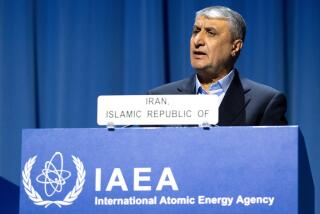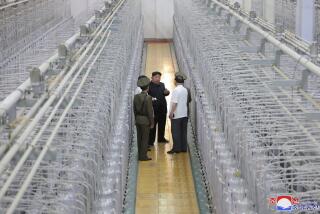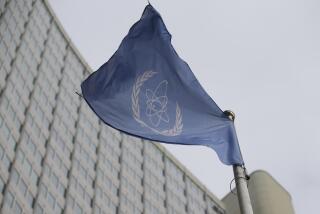Iran says it has increased its number of centrifuges
TEHRAN — Iranian President Mahmoud Ahmadinejad said Saturday that his country had dramatically expanded the number of machines at its disposal producing enriched uranium, defying international demands for the country to halt the production of nuclear material.
But the hard-line leader, quoted by official and semi-official media, also appeared to suggest that Iran might be willing to stop adding more centrifuges, a condition for preliminary talks to end the diplomatic standoff over Iran’s nuclear program.
Experts downplayed the significance of Ahmadinejad’s statement.
“It’s not just the number of centrifuges that counts,” said a Western diplomat in Tehran, who spoke on condition of anonymity. “It’s whether they’re running and how well.”
Still, he said, Ahmadinejad’s assertion won’t help resolve the standoff between Iran and the West.
Speaking to scholars in the northeastern Iranian city of Mashhad, Ahmadinejad said that Iran had more than 5,000 centrifuges. A report by the International Atomic Energy Agency in May said Iran had about 3,500 centrifuges running. Centrifuges can produce nuclear material suitable for generating electricity, or if highly enriched, for use in an atomic bomb.
“The West wanted us to stop,” Ahmadinejad was quoted as telling the scholars. “We resisted, and now they want to resume negotiations.”
There was confusion about the actual number Ahmadinejad cited. One Iranian news agency quoted Ahmadinejad as saying Iran had 6,000 centrifuges working, before taking the report off its website. Another said he referred to “hundreds and thousands” of centrifuges.
In theory, 6,000 centrifuges running continuously can produce enough weapons-grade uranium for one bomb in six months. But Iran has repeatedly asserted that it is not trying to build a nuclear weapon, which its religious leaders have declared un-Islamic. And the Islamic Republic’s enrichment program has also been bedeviled by technical problems, diplomats and arms-control experts say.
Iran says its nuclear program is meant only to provide electricity. But the United States, Israel, Europe and most Western arms-control experts suspect that Iran is trying to at least attain the capability to begin producing bombs quickly if it so decides. Turning the reactor-grade uranium Iran now produces into weapons-grade material is relatively easy, experts say.
Iran says it hopes to eventually have more than 50,000 centrifuges operating at its enrichment plant near the town of Natanz. In April, it said it was on the verge of putting a total of 6,000 centrifuges into operation. Ahmadinejad’s comments Saturday were the first public statement asserting an expansion.
“We knew they were heading toward 6,000 assembled,” said Jeffrey G. Lewis, an arms control expert at the New America Foundation, a think tank. “But there’s some dispute as to whether they’re running them or not.”
European Union foreign policy chief Javier Solana recently offered the Iranians a U.S.-endorsed package of incentives meant to entice them to stop producing enriched uranium. He also proposed a six-week period of pre-negotiations, called “freeze for freeze,” during which Iran would add no centrifuges and the West would refrain from pushing for a fourth round of economic sanctions against it at the U.N. Security Council.
Iran failed to respond to either offer during talks July 19 in Geneva, which were attended by Undersecretary of State William J. Burns in the highest-level diplomatic contact between Tehran and Washington in nearly 30 years.
Solana, Burns and European envoys gave Tehran a deadline of late July to respond to the offer or face a new round of sanctions, which could include prohibitions on selling Iran the refined petroleum products it desperately needs to run its economy.
Iranian officials have decried the deadline and refused to commit to stopping the expansion of the program. But in his latest comments, Ahmadinejad appeared to leave open the possibility that Iran would stop adding centrifuges, though such a freeze would come with a larger number of the devices in place than previously thought, and it would last for longer than the requested six weeks.
“Today they [the West] have agreed that the existing 5,000 to 6,000 centrifuges do not increase and that there is no problem if this number of centrifuges work,” Ahmadinejad was quoted as saying by state radio, according to Agence France-Presse.
U.S. officials have repeatedly stated that no negotiations can begin with Iran before it verifiably halts all enrichment-related activities. But the Bush administration recently softened its stance, agreeing to sign on to the “freeze for freeze” proposal and to send Burns to Geneva.
Ahmadinejad’s comments also suggested breathing room for a compromise, Lewis said.
“If they were going to accept ‘freeze for freeze,’ that’s kind of promising language,” he said. “They’re at least leaving the door open.”
--
Daragahi is a Times staff writer and Mostaghim is a special correspondent.
More to Read
Sign up for Essential California
The most important California stories and recommendations in your inbox every morning.
You may occasionally receive promotional content from the Los Angeles Times.









